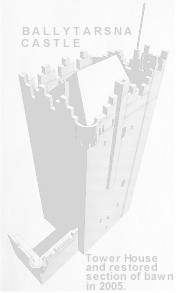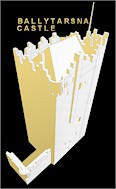 |
BALLYTARSNA CASTLE UPDATE - JAN
2000:
INTRODUCTION
HISTORY
RESTORATION:
PHASE I
PHASE II
PHASE III
THE BAWN
GOAL
BALLYTARSNA CASTLE UPDATE - MARCH
2000:
STONE & LIME WORKSHOP
I first came to Ireland
in 1985 to look at the numerous small castles with an eye for future
acquisition and restoration. I was impressed by the friendliness of the
Irish people, as well as the vast number of castles which were available
for purchase. We returned in August 1998 with
intent to purchase one of four castles which we knew to be for sale, none
of which was Ballytarsna. |
After spending one frustrating month
"haggling" with owners who sought to run up the price, we took to the road and
began to look for another castle. Our first day led us to Ballytarsna, simply
because it was indicated on our map. We jumped the fence and after only 30
minutes of inspection, we knew that this castle was better than any of the
others we had seen, as far as being restorable was concerned. We concluded the
purchase of both tower house and bawn foundations seven months later, dealing
with three landowners in the process. No one was aware that the nearly vanished
bawn was even there.
I have wanted to buy and restore a
castle since I was nine years old. It was no small triumph to finally acquire
what I view as a prime example of a late 15th century Irish tower house and
bawn. I definitely wanted to have a bawn, and not just an isolated tower.
Ballytarsna is exactly what we had hoped to find. For each piece that is
missing, one exists, somewhere else in the castle. Simply put, we know what we
have to do to return this tower house to its original condition.
The history of the castle is sketchy and elusive at best. From the various historical surveys and histories we have read, we have pieced the following history together. Please note that this information
is not exact, nor can it all be verified. Ballytarsna Castle was most likely
built at the end of the 15th century. Both tower house and bawn were definitely
built at the same time as evidenced by the bonding of the bawn wall into the
structure of the tower. The recorded builder of the castle is a Sir William
Hackett, a descendant of the Anglo-Norman settlers of Kildare and Kilkenny.
Ballytarsna Castle became the principal Hackett stronghold in the area in succession to Ballysheehan. In 1654, the castle was occupied by Patrick Hackett. The civil survey of 1654 has this to say: There is on the sayd lands one good Bawn & a Castle wanting
repaire, with severall small cottages. As late as 1890 J.D. white said
... It would not take much to make it livable again. Although it would
appear that the castle gradually fell into disuse in the late 17th century,
sadly, most of the damage has been inflicted during the last 100
years.
Our intent is simple: To carefully
restore the tower house as authentically as possible, while cautiously
installing modern utilities without being intrusive on either the structure or
medieval ambiance of the castle. We have developed our plans accordingly. We
feel that it is risky business to drastically restore a structure that has been
open and wet for centuries, in a single great effort (one year). These
structures will begin to shift as they dry out and warm up. If these two
conditions are suddenly imposed upon an old structure, cracked plaster or even
cracked walls can be the result. Our plan is conservative, as well as patient,
and consists of three phases, to be carried out over a four year
period.
Phase One
Phase one was carried out in summer of 1999. This consisted of blocking up two massive breaches in the ground floor wall, restoring the quoins and facing to the sloping batter, paving the ground floor with a temporary working surface, repairing the stairs, and installing a purpose-made temporary metal roof, as well as temporary safety rails to the top of the tower. Iron doors were installed to the main entrance and wall-walk door, as well as temporary windows to all openings. Basic site preparation was also carried out at this time. Note that all replaced openings
at ground floor are defensive in nature, as the originals certainly would have
been, and are modeled after existing arrow slits.
Phase Two
Phase two will begin two years later, after the tower has had time to dry out properly and most movement of the structure will have taken place. The tower will be scaffolded from top to bottom, as well as on all four sides. The permanent oak and slate roof will be
installed, as well as the crenellation restored to its original condition. The
entire exterior of the tower will be pointed with lime mortar. At this
time, all of the newly cut, fine gothic pointed windows will be installed where
the old ones have vanished. After all this is complete, the entire tower will be
harled, or wet dashed. While this procedure may offend some
sensibilities, it is the way the tower was. There is evidence of harling all
over the tower. This was done to seal out the ill effects of rain and wind. The
fact that the tower was harled is probably the only reason it still stands
today. The harling has worn away and mellowed over time, but the masonry has
remained. The structure will be kept dry, as well as warmer once this protective
coating is reapplied. It is composed of lime mortar and rough sand, and will not
be applied to quoins or any other cut stone feature. The castle will
attain a white appearance after harling, as it did when it was first built. This
whiteness will mellow over a few years time. This procedure will ensure the
survival of the castle for generations to come..
Between now and the beginning of phase two, there is much to accomplish to prepare for all this work. The gable will be raised to its full
height and the wall plate will be restored in order to receive the new roof. The
interior of the tower will also be partially repointed and damaged walls
rebuilt.
Phase Three
Phase three will begin one or two years later. This will include complete restoration of the interior
of the tower. The walls will be lime washed with white lime or plastered with
pure white lime plaster. The oak floors will then be installed under each stone
vault at 1st & 3rd floor level. Utilities and heating will be installed, to
include electrical under-floor heating on 2nd & 4th floors. Three
fireplaces will be restored to working order and a novel stone, oil-fired
radiation system will be installed. All three garderobes will be made
functional. All utilities will be routed through the garderobe shaft to a
small utility building. At this time, the tower house will be finished and
livable.
The
Bawn
Over the next several years, all 609 feet of the bawn wall will be reconstructed on top of existing foundations. The wall will be
12 feet high and 4 to 6 feet thick as was the original, with 5¬Ω foot
crenellation installed, copying those at Ballyragget castle. Several stone
buildings will gradually line the interior of the bawn wall over the years. We
intend to rebuild the wattle and daub hall that once adjoined the west face of
the tower. The roof line of this hall can clearly be seen today on the west face
of the tower. Archeology will reveal the exact dimensions of this
structure.
Goal
Our goal is to make the visitor to Ballytarsna Castle feel that he\she has been transported back to the mid 16th century. The computer generated view of the castle will give you an idea of how it should look in about 7 years time, approx. 2007. Please note that a small square tower on the west bawn wall is suspected to
exist by ourselves and a few architects. It is purely conjectural and will only
be built when proven by sound archeological evidence. The computer generated
view is limited to “square” shapes, so the pointed merlon tops of the crenellation on the tower house are depicted as flat on top. The “stepped” appearance of the gable is also a computer limitation, and will actually be diagonally smooth and unbroken.
STONE & LIME WORKSHOP
WHEN: 10 May 2000 through 26 May 2000.
WHERE: BALLYTARSNA CASTLE, Ballytarsna, Cashel,
County Tipperary, Ireland.
WHAT: INFORMAL INSTRUCTION on lime mortar and
traditional stonework.
HANDS ON EXPERIENCE
- mixing lime mix
- slaking
lime putty
- mixing lime mortar
- raking out stone joints
- repointing
stone joints
- wet dashing walls
- grouting castle walls
- pitching
stone
- tooling (punching) ashlar stone
- assisting Master mason at
work
Stay a couple of days or a couple of weeks. Must be
prepared to work! Lunch, morning tea and scones, and afternoon tea provided. We
do our work the traditional way, with traditional materials. Our masons and
stone carvers are professionals, volunteering for this special project. Come
participate in the restoration of a 15th century castle and take advantage of a
unique opportunity to learn medieval masonry skills on a real medieval castle.
We work weekdays only. Weekends are for touring, and other leisure
activities.
COST: Your work.
SERIOUS ENQUIRIES ONLY PLEASE. Reply via E-mail or Fax for details.
E-MAIL Coucy@bigfoot.com
FAX
001 +281 358 7707

Text by J.C.
Computer generated image (image
source) by J.C.
This Web Page Address (URL)>
http://www.tartanplace.com/tartanillus/thurles/ballytarsnab.htm
Email mailto:Coucy@bigfoot.com
Return to main site page

Image processing / graphic design / web page, by Tipp Web Ltd - 19 Jan 2000, updated 14 March 2000.


